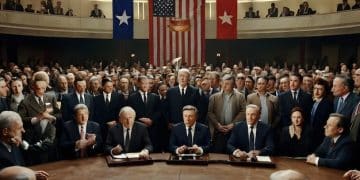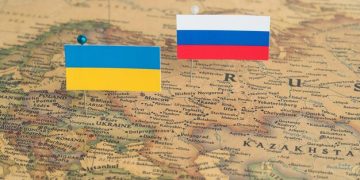US Stance on Nuclear Proliferation: Key Policies & Agreements

The United States actively addresses nuclear proliferation through a multifaceted approach, combining robust key policies, stringent international agreements, and strategic diplomatic engagement to limit the spread of nuclear weapons globally.
Delving into the intricate world of global security, comprehending the US stance on nuclear proliferation: key policies and international agreements is crucial for anyone keen on international relations. This complex subject shapes geopolitical stability and reflects America’s strategic vision for a safer world.
The Historical Foundation of US Non-Proliferation
The United States’ commitment to nuclear non-proliferation is deeply rooted in the aftermath of World War II, a period marked by the dawn of the atomic age. Recognizing the immense destructive potential of nuclear weapons, early US leaders quickly understood the paramount importance of controlling their spread. This understanding evolved from a initial period of nuclear monopoly to a sustained effort to establish international norms and institutions aimed at preventing the acquisition of nuclear weapons by additional states.
This historical context is not merely an academic exercise; it informs the very essence of current US policy. The initial efforts were ad-hoc, focusing on preventing specific nations from developing their own capabilities. Over time, however, a more structured and multilateral approach emerged, culminating in pivotal international agreements. The core philosophy has remained consistent: fewer nuclear weapons states equate to a more secure global environment, reducing the risk of accidental or intentional nuclear conflict.
Early Post-War Concerns and Initiatives
In the immediate post-war years, the US grappled with how to manage its unique nuclear advantage. There was a strong desire to prevent a nuclear arms race, even as Cold War dynamics began to take shape. Early proposals, such as the Acheson-Lilienthal Report and the Baruch Plan, sought international control over atomic energy, advocating for a global atomic development authority. While these efforts ultimately failed due to geopolitical tensions, they laid conceptual groundwork for future non-proliferation measures.
- The Baruch Plan (1946): Proposed international control of atomic energy and a ban on nuclear weapons.
- Atoms for Peace (1953): Introduced by President Eisenhower, promoting peaceful uses of nuclear technology under international safeguards.
- Bilateral agreements: Early efforts to share nuclear technology for peaceful purposes, often with conditions attached to prevent diversion.
These early initiatives, though largely unsuccessful in their grandest ambitions, fostered a recognition that nuclear technology could not be uninvented, and therefore its control required international cooperation. They highlighted the dual-use nature of nuclear technology, capable of generating electricity or bombs, making safeguards and verification critical components of any effective non-proliferation regime.
The Genesis of the Non-Proliferation Treaty (NPT)
The Treaty on the Non-Proliferation of Nuclear Weapons (NPT), opened for signature in 1968, stands as the cornerstone of the international non-proliferation regime. The US played a leading role in its negotiation, recognizing the NPT as a crucial mechanism to formalize and universalize non-proliferation norms. The treaty established a grand bargain: non-nuclear weapon states committed not to acquire nuclear weapons, while nuclear-weapon states promised to pursue disarmament and facilitate peaceful nuclear cooperation.
The NPT’s success lies in its near-universal adherence, making it one of the most widely ratified treaties in history. It has been instrumental in limiting the number of nuclear-weapon states to nine, far fewer than initially predicted in the mid-20th century. The US view of the NPT is that it forms an indispensable framework for global security, balancing disarmament, non-proliferation, and peaceful nuclear energy. Any erosion of the NPT’s credibility or effectiveness is seen as a direct threat to international stability.
In essence, the historical trajectory of US non-proliferation policy demonstrates an evolution from unilateral control to multilateral engagement and the establishment of robust international frameworks. This journey underscores a persistent national security imperative to mitigate the most existential threat posed by the proliferation of nuclear weapons.
Key Pillars of US Non-Proliferation Policy
The US non-proliferation strategy is built upon several interconnected pillars, each addressing a unique facet of the proliferation challenge. This multi-pronged approach reflects the complexity and evolving nature of nuclear threats, requiring both proactive measures and reactive responses. The primary objective is to deny and deter the acquisition of nuclear weapons, or the materials and technology to build them, by states and non-state actors.
These pillars range from diplomatic engagement and arms control to physical security and counter-proliferation measures, emphasizing that there is no single solution to such a pervasive global issue. The effectiveness of this policy relies heavily on international cooperation and the willingness of other nations to adhere to the established norms and agreements. Without such collaboration, even the most robust national policies would face significant limitations.
Diplomatic Engagement and Multilateralism
Diplomacy remains the primary tool in the US non-proliferation toolkit. The US actively engages in bilateral and multilateral dialogues to reinforce global non-proliferation norms, resolve disputes, and encourage adherence to international treaties. This includes working through platforms such as the United Nations, the Group of Seven (G7), and various ad-hoc coalitions formed to address specific proliferation concerns. Diplomatic pressure, sanctions, and incentives are often combined to persuade states to abandon or forgo nuclear weapons programs.
- UN Security Council resolutions: Instrumental in enforcing non-proliferation norms and imposing sanctions on violators.
- P5+1 negotiations: Exemplified by the Iran nuclear deal (JCPOA), showcasing multilateral efforts to curb proliferation.
- Regional security dialogues: Promoting confidence-building measures and transparency in sensitive regions.
The US believes that a strong, unified international front is essential to deter proliferation effectively. This focus on multilateralism underscores a recognition that nuclear dangers transcend national borders, requiring collective action and shared responsibility. Diplomacy also plays a crucial role in building trust and fostering transparent communication, which are vital for verifying compliance with non-proliferation commitments.
Arms Control Treaties and Disarmament Efforts
While distinct from non-proliferation, arms control and disarmament are inextricably linked components of the US strategy. By reducing existing nuclear stockpiles and limiting modernization, the US signals its commitment to the NPT’s disarmament pillar, thereby strengthening its moral authority to demand non-proliferation from others. Treaties like the Strategic Arms Reduction Treaty (START) between the US and Russia demonstrate concrete steps towards reducing the nuclear threat.
However, the landscape of arms control has become more challenging, with emerging technologies and new geopolitical realities posing significant hurdles. Despite these difficulties, the US continues to advocate for verifiable arms control agreements, believing them to be indispensable for managing strategic stability and reducing the risk of miscalculation. The pursuit of general and complete disarmament, as envisaged by the NPT, remains a long-term aspiration, even if its immediate realization appears distant.

Counter-Proliferation and Export Controls
Counter-proliferation encompasses active measures to detect, deter, prevent, and respond to nuclear proliferation, particularly concerning illicit trafficking of nuclear materials and technology. This includes intelligence gathering, interdiction efforts, and strengthened export controls. The Proliferation Security Initiative (PSI), led by the US, is an example of international cooperation aimed at stopping the illegal shipment of WMD-related materials.
Stringent export controls prevent sensitive technologies and materials from falling into the wrong hands. The US maintains strict regulations on the transfer of dual-use items that could contribute to nuclear weapons programs, working closely with international bodies like the Nuclear Suppliers Group (NSG) to harmonize these controls globally. This proactive approach aims to starve illicit programs of the resources they need to advance their capabilities.
These core pillars collectively form a comprehensive and adaptive framework for the US to address the multifaceted challenges of nuclear proliferation. They represent a dynamic balance between diplomatic persuasion, legal frameworks, and practical measures to secure global peace and prevent catastrophic outcomes.
International Agreements Shaping US Policy
International agreements form the legal and normative backbone of the US non-proliferation policy. These treaties, conventions, and operational frameworks provide consistency, legitimacy, and a shared understanding among nations about the responsibilities and obligations associated with nuclear technology. The US actively participates in and often leads efforts to strengthen these instruments, viewing them as essential for building a global consensus against the spread of nuclear weapons.
The adherence to these agreements is not merely a formality; it reflects a deeply held belief within US foreign policy circles that multilateral norms are more effective than unilateral actions in dealing with a threat that transcends national borders. These frameworks also provide a basis for accountability, allowing the international community to monitor compliance and address deviations from agreed-upon standards.
The Non-Proliferation Treaty (NPT): Cornerstone
As discussed, the NPT is paramount. The US champions the treaty’s three pillars: non-proliferation, disarmament, and the peaceful use of nuclear energy. For the US, it’s a living document that continually requires reinforcement through review conferences, adherence by all states, and robust verification measures. The US actively works to ensure the International Atomic Energy Agency’s (IAEA) capacity to monitor NPT compliance.
- Universal Adherence: The US actively encourages the few remaining non-signatories to join the NPT.
- Comprehensive Safeguards: Supports the IAEA’s efforts to implement robust safeguards, including the Additional Protocol.
- Disarmament Obligations: Acknowledges its own obligations under Article VI of the NPT to pursue good faith negotiations on nuclear disarmament.
The NPT remains central to US policy, providing the overarching framework within which all other non-proliferation efforts are conducted. Its continued relevance is a testament to its foundational role in international security, a role that the US is committed to upholding and strengthening against various contemporary challenges.
Comprehensive Nuclear-Test-Ban Treaty (CTBT)
The CTBT prohibits all nuclear weapons test explosions in all environments. Although the US signed the CTBT in 1996, it has not yet ratified it, a point of contention internationally. Despite this, the US maintains a moratorium on nuclear testing and supports the development of the CTBT’s international monitoring system and verification regime. Its non-ratification stems from domestic political considerations and debates over verification effectiveness and national security implications.
Despite not being a state party to the CTBT, the US nuclear testing moratorium has been in effect for decades. This voluntary restraint signals a de facto commitment to the treaty’s objective and contributes to the global norm against nuclear testing. Should the US ratify the CTBT, it would significantly bolster the treaty’s entry into force and strengthen the global non-proliferation architecture.
Additional Protocols and IAEA Safeguards
Beyond the NPT, the Additional Protocol (AP) to states’ safeguards agreements with the IAEA significantly enhances the Agency’s ability to verify the peaceful nature of nuclear programs. The AP grants the IAEA broader inspection rights and access to information, allowing for a more comprehensive assessment of a state’s nuclear activities. The US strongly advocates for the universal adoption and implementation of the AP, viewing it as an essential tool for detecting undeclared nuclear activities.
IAEA safeguards generally apply to declared nuclear materials and facilities. The AP addresses concerns about undeclared activities, providing a more robust framework for verifying compliance with non-proliferation commitments. The US has been a strong proponent of strengthening the IAEA’s capabilities, regularly contributing financial and technical support to enhance its ability to conduct inspections and analyses worldwide. This support is critical given the agency’s vital role in providing confidence in the peaceful use of nuclear energy.
These international agreements, along with the US’s active engagement in them, collectively form a complex web of legal and political commitments designed to contain and ultimately roll back the threat of nuclear proliferation. Their strength lies in their interconnectivity and the shared understanding they foster among the global community.
Challenges and Evolving Threats to Non-Proliferation
Despite robust policies and international agreements, the US non-proliferation agenda faces persistent and evolving challenges. The global security landscape is dynamic, with technological advancements, geopolitical shifts, and the emergence of new actors constantly testing the existing framework. These challenges demand adaptability and a continuous re-evaluation of strategies to maintain the effectiveness of non-proliferation efforts.
The nature of proliferation itself has become more complex. While state-level proliferation remains a primary concern, the risk of non-state actors or terrorist groups acquiring nuclear materials or weapons presents a daunting new challenge. Furthermore, the spread of sensitive technologies through illicit networks, often facilitated by dual-use components, complicates detection and interdiction efforts. Addressing these multifaceted threats requires an integrated approach that goes beyond traditional state-centric diplomacy.
Rogue States and State-Sponsored Programs
Certain states, often labeled as “rogue states” due to their defiance of international norms, pose significant proliferation challenges. North Korea’s continued development of nuclear weapons and ballistic missile capabilities, despite international sanctions and condemnation, represents a direct challenge to the NPT and global stability. Similarly, concerns surrounding Iran’s nuclear program have led to intense diplomatic efforts and a multilateral agreement (JCPOA), though its future remains uncertain after the US withdrawal.
The US employs a combination of diplomatic pressure, economic sanctions, and the threat of military action to deter and roll back such programs. The goal is to prevent these states from acquiring or expanding their nuclear arsenals, thereby reducing the risk of horizontal proliferation and regional instability. However, these situations are often characterized by complex geopolitical dynamics, requiring careful calibration of responses to avoid unintended escalation.
Nuclear Terrorism and Non-State Actors
The specter of nuclear terrorism is arguably one of the most terrifying threats facing the world today. Should a non-state actor acquire even a rudimentary nuclear device or enough fissile material to create a “dirty bomb,” the consequences would be catastrophic. The US places a high priority on preventing this scenario by enhancing global nuclear security, securing vulnerable materials, and improving intelligence sharing.
- Global Nuclear Security Summits: US-led initiatives to address the threat of nuclear terrorism by securing all vulnerable nuclear materials.
- Cooperative Threat Reduction Programs: Bilateral programs aimed at dismantling WMDs and securing materials in former Soviet states.
- Interdiction efforts: Working with international partners to disrupt illicit trafficking networks.
The challenge from non-state actors is particularly insidious because these groups often operate outside traditional state structures and are less susceptible to conventional deterrence strategies. This necessitates a strong emphasis on preventative measures, including physical security of nuclear materials, improved intelligence, and strong international cooperation to trace and interdict illegal trade routes. The Proliferation Security Initiative (PSI) is a crucial example of multilateral effort in this domain.

Technological Advancements and Cyber Threats
Rapid advancements in dual-use technologies present new challenges for non-proliferation. Technologies in areas like additive manufacturing (3D printing), artificial intelligence, and advanced computing can accelerate the development of weapons programs or enable novel delivery systems. Monitoring and controlling the spread of these technologies, which have legitimate civilian applications, is incredibly complex.
Furthermore, cyber threats to nuclear infrastructure are a growing concern. Malicious cyber activities could target nuclear facilities, potentially leading to safety incidents, theft of sensitive information, or even attempts to gain control of operational systems. The US is increasingly focused on enhancing the cybersecurity of nuclear facilities globally and developing strategies to counter such threats, recognizing that digital vulnerabilities can have real-world catastrophic consequences.
These evolving challenges mean that the US non-proliferation strategy must be agile and comprehensive, continually adapting to new threats while reinforcing the existing international norms and agreements. The dynamic nature of proliferation requires constant vigilance and robust international collaboration to minimize risks and ensure global security.
Future Directions and Adaptations of US Policy
The United States’ approach to nuclear non-proliferation is not static; it continually adapts to a changing global security landscape. Looking ahead, future US policy will likely emphasize innovation in both diplomatic and technological spheres, seeking to strengthen the existing non-proliferation regime while addressing new and emergent threats. The goal remains consistent: to prevent the spread of nuclear weapons and, ultimately, to reduce their role in international security.
Adaptations will likely include a greater focus on regional specificities, as proliferation challenges often manifest differently in various parts of the world. There will also be a continued emphasis on deterrence and defense, ensuring that the US and its allies can effectively counter any nuclear threat while simultaneously pursuing non-proliferation objectives. The balance between these elements will be critical for maintaining stability.
Strengthening Treaty Compliance and Verification
A key focus for future US policy will be to reinforce the integrity of existing treaties, particularly the NPT. This involves encouraging universal adherence, promoting the adoption of the Additional Protocol, and ensuring the IAEA has the necessary resources and authorities to conduct robust verification activities. The US will likely continue to lead efforts to enhance the transparency and accountability of all nuclear programs.
Improving the detectability of covert nuclear activities will be paramount. This could involve investing in advanced remote sensing technologies, improving intelligence sharing among partner nations, and developing new analytical methods for interpreting safeguards data. The aim is to make it increasingly difficult for states to pursue clandestine weapons programs without detection, thereby increasing the risk and cost of non-compliance.
Addressing Emerging Technologies and Materials
As technological advancements continue, future US policy will need to proactively address their implications for nuclear proliferation. This includes the proliferation risks posed by advanced manufacturing techniques, artificial intelligence in weapons development, and the potential for a new generation of cheaper, smaller nuclear weapons. Policy will need to balance the legitimate civilian uses of these technologies with their proliferation potential.
Furthermore, the management of fissile materials, particularly plutonium and highly enriched uranium, remains a critical long-term challenge. Future policy will likely explore innovative approaches to reducing global stockpiles of these materials, ensuring their secure storage, and developing proliferation-resistant fuel cycles for civilian nuclear energy. The aim is to minimize the availability of the raw ingredients for nuclear weapons.
Regional Approaches and Deterrence Strategies
The US historically has applied global non-proliferation norms, but future policy may increasingly involve tailored regional approaches. Proliferation challenges in the Middle East, East Asia, and South Asia have distinct geopolitical contexts that necessitate bespoke diplomatic and security strategies. This involves working with regional partners to build security frameworks that discourage proliferation and address underlying security concerns that might motivate states to pursue nuclear weapons.
Deterrence will continue to be a crucial component. For states that already possess nuclear weapons or are on the threshold, the US will maintain a credible deterrent while simultaneously seeking dialogue and risk reduction measures. This involves a delicate balance of demonstrating resolve and maintaining open channels for communication to prevent miscalculation and escalation during crises.
Ultimately, the future of US nuclear non-proliferation policy will be characterized by a continuous effort to innovate, adapt, and cooperate internationally. The enduring goal is to mitigate the most existential threat facing humanity, ensuring a more stable and secure global environment for generations to come, based on a strong foundation of diplomacy, verifiable agreements, and robust security measures.
Successes, Failures, and Lessons Learned
Evaluating the US stance on nuclear proliferation requires an honest assessment of both its triumphs and its setbacks. The journey to containing nuclear weapons has been fraught with challenges, yet it has also seen remarkable achievements. Learning from these experiences is crucial for refining future strategies and adapting to the evolving nature of global security threats. Understanding what worked and what didn’t provides invaluable insights into the complexities of international diplomacy and security.
The successes highlight the potential for multilateral cooperation and the effectiveness of robust verification mechanisms. The failures, on the other hand, underscore the difficulty of imposing external solutions on sovereign states and the persistent allure of nuclear weapons for certain regimes seeking security or prestige. This dual perspective informs the continuous refinement of US non-proliferation efforts, pushing for strategies that are both ambitious and realistically achievable.
Notable Successes in Non-Proliferation
One of the most significant successes is the sheer fact that the number of nuclear-weapon states has remained remarkably low, far fewer than many analysts predicted during the Cold War. The NPT, largely championed by the US, has played a pivotal role in this achievement, creating a powerful global norm against proliferation. Without it, the world would likely be a much more dangerous place, with potentially dozens of nuclear-armed countries.
- De-nuclearization of South Africa: A prime example of a state voluntarily dismantling its nuclear arsenal.
- Denial of nuclear ambition in Libya: Gaddafi’s decision to abandon WMD programs after diplomatic pressure.
- Former Soviet Union disarmament: Cooperative Threat Reduction programs securing vast quantities of WMD materials.
These successes demonstrate that a combination of strong international norms, diplomatic pressure, economic incentives, and credible security assurances can effectively persuade states to forgo or discard nuclear weapons programs. The US leadership in these instances was often crucial, providing the political will and resources necessary to achieve these outcomes.
Persistent Failures and Unresolved Cases
Despite successes, significant failures persist, notably the ongoing nuclear proliferation by North Korea and the unresolved concerns surrounding Iran’s nuclear program. North Korea’s withdrawal from the NPT and its relentless pursuit of nuclear weapons and missile technologies illustrate the limitations of current non-proliferation tools against a determined and isolated regime. Similarly, the challenges with Iran highlight the complexities of verification and the difficulty of reaching comprehensive, lasting agreements with states that harbor deep suspicions.
These cases underscore the reality that while the non-proliferation regime is robust, it is not infallible. They also reveal the limits of sanctions alone to compel compliance and raise questions about the efficacy of military threats without a clear diplomatic off-ramp. Furthermore, the development of sophisticated missile technology by various actors complicates the strategic landscape, blurring the lines between conventional and nuclear deterrence.
Lessons Learned and Future Implications
The experiences of the past decades offer critical lessons. First, a strong, adaptable multilateral framework like the NPT is indispensable but requires constant reinforcement and universal adherence. Second, diplomatic engagement, even with adversaries, is crucial for finding pathways to de-escalation and verifiable agreements. Third, credible deterrence and defensive capabilities must coexist with non-proliferation efforts, providing security while discouraging acquisition.
Finally, addressing the underlying security dilemmas that motivate states to pursue nuclear weapons is vital for long-term success. This involves regional stability initiatives and building trust. The future of non-proliferation will require innovative thinking, strategic patience, and an unwavering commitment to the ultimate goal of a world free of nuclear threats. The lessons from past successes and failures provide the foundation for this ongoing, critical endeavor.
| Key Policy | Brief Description |
|---|---|
| 🤝 Diplomatic Engagement | Active participation in multilateral forums and bilateral talks to prevent nuclear weapons spread. |
| 📜 NPT Adherence | Strong commitment to the Non-Proliferation Treaty as the cornerstone of global security. |
| 🛡️ Counter-Proliferation Measures | Intelligence, interdiction, and export controls to stop illicit WMD materials trafficking. |
| 🌐 IAEA Safeguards | Support for international monitoring and verification of peaceful nuclear programs. |
Frequently Asked Questions about US Non-Proliferation
The primary goal of US nuclear non-proliferation policy is to prevent the spread of nuclear weapons and related technologies, thereby reducing the risk of nuclear conflict and enhancing global security. This includes preventing both states and non-state actors from acquiring such capabilities.
The Nuclear Non-Proliferation Treaty (NPT) is considered the cornerstone of the US and global non-proliferation regime. The US actively advocates for its universal adherence and robust implementation, believing it provides the essential legal and normative framework for preventing nuclear weapons spread.
“Dual-use” technologies are items, software, or information that can be used for both legitimate civilian purposes and for developing weapons of mass destruction. Controlling their proliferation is a significant challenge for US policy, requiring careful regulation and international cooperation.
Yes, the US supports the NPT’s disarmament pillar and has reduced its own nuclear arsenal significantly since the Cold War. While distinct from non-proliferation, disarmament efforts are seen as crucial for strengthening the moral authority of the non-proliferation regime and promoting global stability.
The International Atomic Energy Agency (IAEA) plays a crucial role as the world’s nuclear watchdog. The US strongly supports the IAEA’s efforts to verify that states adhere to their non-proliferation obligations, particularly through comprehensive safeguards and the Additional Protocol, providing confidence in peaceful nuclear programs.
Conclusion and Future Outlook
The US stance on nuclear proliferation, characterized by a blend of robust policies and unwavering commitment to international agreements, represents a critical pillar of global security. From the foundational NPT to active counter-proliferation measures, the US continually navigates a complex and evolving landscape of threats. The challenges posed by rogue states, technological advancements, and the specter of nuclear terrorism underscore the perpetual need for vigilance, adaptive strategies, and sustained international cooperation. As the world moves forward, the success of non-proliferation efforts will depend on the continued ability to forge consensus, enforce norms, and innovate solutions to safeguard humanity from the most devastating of weapons.





